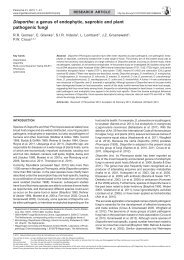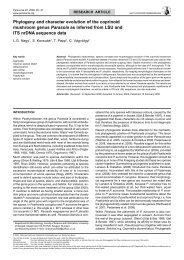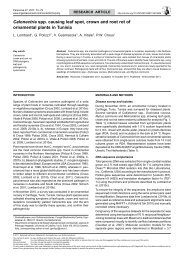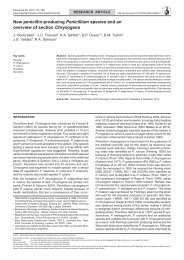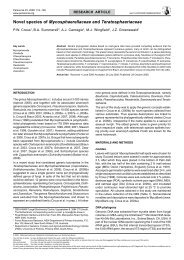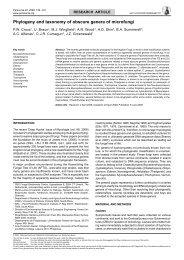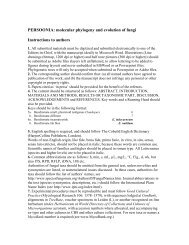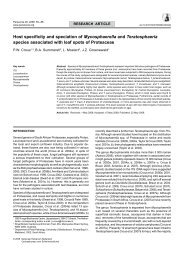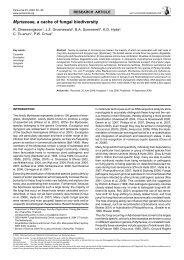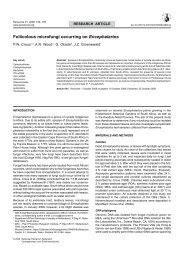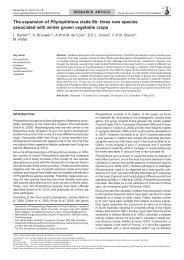Polyphasic taxonomy of the heat resistant ascomycete ... - Persoonia
Polyphasic taxonomy of the heat resistant ascomycete ... - Persoonia
Polyphasic taxonomy of the heat resistant ascomycete ... - Persoonia
You also want an ePaper? Increase the reach of your titles
YUMPU automatically turns print PDFs into web optimized ePapers that Google loves.
R.A. Samson et al.: <strong>Polyphasic</strong> <strong>taxonomy</strong> <strong>of</strong> Byssochlamys<br />
15<br />
Table 1 Byssochlamys and Paecilomyces isolates examined in this study.<br />
Species Accession No. Source and notes<br />
B. fulva CBS 132.33 Bottled fruit, UK; ex-type <strong>of</strong> Paecilomyces fulvus<br />
CBS 146.48 T<br />
Bottled fruit, UK<br />
CBS 135.62<br />
Fruit juice, Switzerland; ex-type <strong>of</strong> Paecilomyces todicus<br />
CBS 604.71<br />
Unknown source<br />
CBS 113954 Unknown source, patulin producer acc. to Rice et al. (1977)<br />
B. lagunculariae CBS 373.70 T Wood <strong>of</strong> Laguncularia racemosa (Mangue), Brazil<br />
CBS 696.95<br />
Pasteurized strawberries, <strong>the</strong> Ne<strong>the</strong>rlands<br />
CBS 110378<br />
Unknown source, France<br />
B. nivea CBS 100.11 T Unknown source<br />
CBS 133.37<br />
Milk <strong>of</strong> cow, USA; ex-type <strong>of</strong> Arachniotus trisporus<br />
CBS 271.95<br />
Mushroom bed, China<br />
CBS 102192<br />
Pasteurized drink yoghurt, Belgium<br />
CBS 113245<br />
Pasteurized fruit juice, Switzerland<br />
B. spectabilis CBS 338.51 Fruit juice, Switzerland<br />
CBS 102.74<br />
Unknown source; ex-type <strong>of</strong> Paecilomyces variotii<br />
CBS 101075 T<br />
Heat processed fruit beverage, Japan<br />
CBS 121581<br />
Spoiled sweetened tea, USA<br />
B. verrucosa CBS 605.74 T Nesting material <strong>of</strong> Leipoa ocellata, Australia<br />
B. zollerniae CBS 374.70 T Wood <strong>of</strong> Zollernia ilicifolia and Protium heptaphyllum, Brazil<br />
P. brunneolus CBS 370.70 T Non fat dry milk, Canada<br />
P. divaricatus CBS 284.48 T Mucilage bottle with library paste, USA<br />
CBS 110429<br />
Pectin, Mexico<br />
P. formosus CBS 628.66 Quebracho-tanned sheep lea<strong>the</strong>r, France<br />
CBS 371.70<br />
Annona squamosa, Brazil; ex-type <strong>of</strong> Paecilomyces maximus<br />
CBS 990.73B T<br />
Unknown source<br />
CBS 296.93<br />
Man, bone marrow <strong>of</strong> patient, Uzbekistan<br />
CBS 113247<br />
Soil, Thailand<br />
CBS 372.70<br />
Lecythis unsitata (Lecythidaceae), wood, Brazil; ex-type strain <strong>of</strong> P. lecythidis<br />
P. saturatus CBS 323.34 T Unknown source; ex-type <strong>of</strong> Paecilomyces mandshuricus var. saturatus<br />
CBS 368.70<br />
Medicine containing quinine, UK<br />
CBS 251.55 T<br />
Acetic acid, Brazil; ex-type <strong>of</strong> P. dactylomorphys<br />
CBS 990.73A<br />
Unknown source; ex-type <strong>of</strong> Penicillium viniferum<br />
CBS 492.84<br />
Lepidium sativum, Denmark<br />
Talaromyces byssochlamydoides CBS 413.71 T Dry soil under Pseudotsuga menziesii, USA<br />
Talaromyces emersonii CBS 393.64 T Compost, Italy<br />
Thermoascus crustaceus CBS 181.67 T Par<strong>the</strong>nium argentatum (Compositae), decaying plant, USA<br />
robustness <strong>of</strong> <strong>the</strong> most parsimonious trees was evaluated with<br />
1 000 bootstrap replications (Hillis & Bull 1993). O<strong>the</strong>r statistics,<br />
including tree length, consistency index, retention index and<br />
rescaled consistency index (CI, RI and RC) were calculated.<br />
Monascus pilosus (GenBank accession AY629427) was used<br />
as an outgroup in <strong>the</strong> analyses <strong>of</strong> <strong>the</strong> ITS dataset; Thermoascus<br />
crustaceus was used as an outgroup for <strong>the</strong> β-tubulin and calmodulin<br />
data. Newly generated sequences were deposited in<br />
GenBank with accession numbers FJ389920–FJ390009. The<br />
alignments generated and <strong>the</strong> most parsimonious trees were<br />
deposited in TreeBase under accession numbers S2199 and<br />
M4168–M4170.<br />
Morphological characterisation<br />
The media used for macro-morphological examination included<br />
Czapek yeast autolysate (CYA) agar, malt extract autolysate<br />
(MEA) agar, yeast extract sucrose (YES) agar and creatinesucrose<br />
(CREA) agar (media compositions were according to<br />
Samson et al. 2004). Isolates were incubated at 25, 30 and<br />
37 °C. Micromorphological characterisation <strong>of</strong> <strong>the</strong> asexual<br />
Paecilomyces state was carried out on MEA, hay agar (HAY)<br />
and YES agars. The latter was exclusively used to determine<br />
<strong>the</strong> presence <strong>of</strong> chlamydospores. For <strong>the</strong> analyses <strong>of</strong> <strong>the</strong> features<br />
<strong>of</strong> <strong>the</strong> sexual Byssochlamys state, <strong>the</strong> media oatmeal<br />
agar (OA) and potato-dextrose agar (PDA) were used (for<br />
media formulations, see Samson et al. 2004). The surfaces<br />
<strong>of</strong> conidia, chlamydospores and ascospores were examined<br />
after prolonged incubation (up to 70 d). Conditions and media<br />
for measuring <strong>the</strong> microaerophily, growth on 0.5 % acetic acid<br />
and <strong>the</strong> resistance to propionic acid are described by Frisvad<br />
& Samson (2004).<br />
Extrolite analysis<br />
Strains studied (Table 1) were three-point inoculated on MEA,<br />
YES, PDA, OA and CYA agars. All isolates were analysed for<br />
extrolite metabolites after 2 wk growth at 30 °C. The cultures<br />
were extracted according <strong>the</strong> method <strong>of</strong> Smedsgaard (1997)<br />
and analysed with high performance liquid chromatography<br />
(HPLC) with diode array detection (DAD) (Frisvad & Thrane<br />
1987, 1993). The metabolites found were compared with a<br />
spectral UV library derived from au<strong>the</strong>ntic standards, including<br />
patulin, viriditoxin, mycophenolic acid, byssochlamic acid and<br />
physcion, using <strong>the</strong> same conditions (<strong>the</strong> maximum similarity<br />
is a match <strong>of</strong> 1 000). The retention indices were compared with<br />
those <strong>of</strong> standards.<br />
Results<br />
DNA sequencing<br />
The trees constructed by maximum parsimony analysis <strong>of</strong> <strong>the</strong><br />
datasets <strong>of</strong> <strong>the</strong> protein coding genes β-tubulin and calmodulin<br />
and <strong>the</strong> ITS region exhibited similar topologies (Fig. 1–3).<br />
Molecular analyses revealed that in <strong>the</strong> genus Byssochlamys<br />
nine taxa can be recognised. Five taxa form a teleomorph,<br />
namely B. fulva, B. lagunculariae, B. nivea, B. spectabilis and<br />
B. zollerniae, while four are strictly anamorphic, i.e. P. brunneolus,<br />
P. divaricatus, P. formosus and P. saturatus. Analyses<br />
<strong>of</strong> <strong>the</strong> ITS showed that B. verrucosa is not a member <strong>of</strong> <strong>the</strong><br />
genus Byssochlamys and is related to Thermoascus (Fig. 1).<br />
This was also confirmed by analyses <strong>of</strong> <strong>the</strong> partial β-tubulin<br />
and calmodulin sequence data (data not shown).<br />
The basal nodes were also similar for all three parsimony<br />
trees (Fig. 1–3). Byssochlamys nivea and B. fulva were sister



